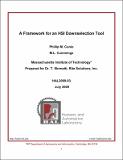A Framework for an HSI Downselection Tool
Author(s)
Cunio, Phillip M.; Cummings, M. L.
DownloadHAL2009-03.pdf (635.5Kb)
Other Contributors
Massachusetts Institute of Technology. Dept. of Aeronautics and Astronautics. Humans and Automation Laboratory
Metadata
Show full item recordAbstract
This technical report describes the concept and development of SITHE, the Systems Integration
Tool for HSI Evaluation. SITHE is a framework for selecting tools to be used in evaluating
complex technical systems in terms of Human-Systems Integration, or HSI.
HSI, or Human-Systems Integration, is the process of integrating people, technology, and an
organization at a systems level, with full consideration given to the human requirements of the
user (Booher, 2003). HSI focuses on the human aspects of system definition, development, and
deployment, and integrates considerations related to personnel, training, human factors,
habitability, and other human-related concerns into the overall systems acquisition process (US
Department of Defense, 2004). HSI is a field of interest to researchers in academia and industry
because, although systems continue to grow more complex, they have not achieved the level of
autonomy that would permit them to operate successfully without humans either in or on the
loop. Humans are still an essential component of most complex systems, especially when the
context of operation for the complex system is subject to uncertainty, as in military applications.
However, HSI as a broad field can encompass a large number of types of interaction between
humans and systems, including but not necessarily limited to supervisory control, mechanics and
ergonomics of control operation, and visualization and decision support.
The universe of tools for HSI (including hardware, software, processes, and techniques used to
evaluate HSI aspects of complex systems) is already large and growing quickly. Many HSI tools
are developed for research purposes only, or in an ad-hoc fashion for specific projects, and as
such there is no such thing as a standard catalogue of HSI tools. In addition, the need to consider
downstream competencies such as flexibility, robustness, and usability, is increasing as HSI
systems become more complex. Thus the HSI cost-benefit trade space is ever increasing, making
it difficult for decision makers to determine if and to what degree a system actually meets some
pre-specified HSI criteria.
Date issued
2009Publisher
MIT Humans and Automation Laboratory
Series/Report no.
HAL Reports;HAL2009-03